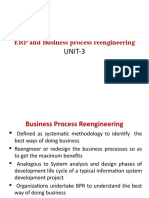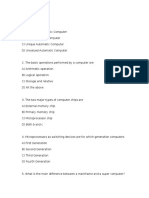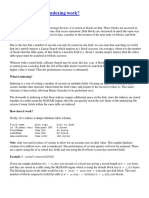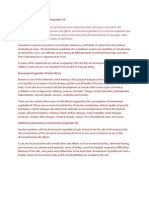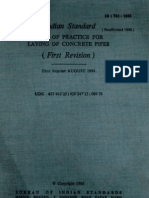Random-Access Files: Example
Random-Access Files: Example
Uploaded by
Aaron BrownCopyright:
Available Formats
Random-Access Files: Example
Random-Access Files: Example
Uploaded by
Aaron BrownOriginal Description:
Original Title
Copyright
Available Formats
Share this document
Did you find this document useful?
Is this content inappropriate?
Copyright:
Available Formats
Random-Access Files: Example
Random-Access Files: Example
Uploaded by
Aaron BrownCopyright:
Available Formats
645
EXAMPLE
C+ + By
31
Random-Ac c ess
Files
This chapter introduces the concept of random file access. Random
file access enables you to read or write any data in your disk file
without having to read or write every piece of data before it. You can
quickly search for, add, retrieve, change, and delete information in
a random-access file. Although you need a few new functions to
access files randomly, you find that the extra effort pays off in
flexibility, power, and speed of disk access.
This chapter introduces
o Random-access files
o File records
o The seekg( ) function
o Special-purpose file I/O functions
With C++s sequential and random-access files, you can do
everything you would ever want to do with disk data.
Chapter 31 o Random -Access Files
646
Random File Rec ords
Random files exemplify the power of data processing with
C++. Sequential file processing is slow unless you read the entire
file into arrays and process them in memory. As explained in
Chapter 30, however, you have much more disk space than RAM,
and most disk files do not even fit in your RAM at one time.
Therefore, you need a way to quickly read individual pieces of
data from a file in any order and process them one at a time.
Generally, you read and write file records. A record to a file is
analogous to a C++ structure. A record is a collection of one or more
data values (called fields) you read and write to disk. Generally, you
store data in structures and write the structures to disk where they
are called records. When you read a record from disk, you generally
read that record into a structure variable and process it with your
program.
Unlike most programming languages, not all disk data for C++
programs has to be stored in record format. Typically, you write a
stream of characters to a disk file and access that data either sequen-
tially or randomly by reading it into variables and structures.
The process of randomly accessing data in a file is simple. Think
about the data files of a large credit card organization. When you
make a purchase, the store calls the credit card company to receive
authorization. Millions of names are in the credit card companys
files. There is no quick way the credit card company could read
every record sequentially from the disk that comes before yours.
Sequential files do not lend themselves to quick access. It is not
feasible, in many situations, to look up individual records in a data
file with sequential access.
The credit card companies must use a random file access so
their computers can go directly to your record, just as you go directly
to a song on a compact disk or record album. The functions you use
are different from the sequential functions, but the power that
results from learning the added functions is worth the effort.
When your program reads and writes files randomly, it treats
the file like a big array. With arrays, you know you can add, print,
or remove values in any order. You do not have to start at the first
A record to a fi l e i s
l i ke a structure to
vari abl es.
You do not have to
rewri te an enti re fi l e
to change random-
access fi l e data.
647
EXAMPLE
C+ + By
array element, sequentially looking at the next one, until you get the
element you need. You can view your random-access file in the same
way, accessing the data in any order.
Most random file records are fixed-length records. Each record
(usually a row in the file) takes the same amount of disk space.
Most of the sequential files you read and wrote in the previous
chapters were variable-length records. When you are reading or
writing sequentially, there is no need for fixed-length records be-
cause you input each value one character, word, string, or number
at a time, and look for the data you want. With fixed-length records,
your computer can better calculate where on the disk the desired
record is located.
Although you waste some disk space with fixed-length records
(because of the spaces that pad some of the fields), the advantages
of random file access compensate for the wasted disk space (when
the data do not actually fill the structure size).
TIP: With random-access files, you can read or write records
in any order. Therefore, even if you want to perform sequential
reading or writing of the file, you can use random-access
processing and randomly read or write the file in sequential
record number order.
Opening Random-Ac c ess
Files
Just as with sequential files, you must open random-access files
before reading or writing to them. You can use any of the read access
modes mentioned in Chapter 30 (such as i os: : i n) only to read a file
randomly. However, to modify data in a file, you must open the file
in one of the update modes, repeated for you in Table 31.1.
Chapter 31 o Random -Access Files
648
Table 31.1. Random-ac c ess update modes.
Mode Description
app Open the file for appending (adding to it)
at e Seek to end of file on opening it
i n Open file for reading
out Open file for writing
bi nar y Open file in binary mode
t r unc Discard contents if file exists
nocr eat e If file doesnt exist, open fails
nor epl ace If file exists, open fails unless appending or seeking to
end of file on opening
There is really no difference between sequential files and
random files in C++. The difference between the files is not physical,
but lies in the method you use to access them and update them.
Examples
1. Suppose you want to write a program to create a file of your
friends names. The following open( ) function call suffices,
assuming f p is declared as a file pointer:
f p. open( NAMES. DAT, i os: : out ) ;
i f ( ! f p)
{ cout << \ n*** Cannot open f i l e ***\ n; }
No update open( ) access mode is needed if you are only
creating the file. However, what if you wanted to create the
file, write names to it, and give the user a chance to change
any of the names before closing the file? You then have to
open the file like this:
f p. open( NAMES. DAT, i os: : i n | i os: : out ) ;
i f ( ! f p)
cout << \ n*** Cannot open f i l e ***\ n;
649
EXAMPLE
C+ + By
This code enables you to create the file, then change data
you wrote to the file.
2. As with sequential files, the only difference between using a
binary open( ) access mode and a text mode is that the file
you create is more compact and saves disk space. You
cannot, however, read that file from other programs as an
ASCII text file. The previous open( ) function can be rewritten
to create and allow updating of a binary file. All other file-
related commands and functions work for binary files just as
they do for text files.
f p. open( NAMES. DAT, i os: : i n | i os: : out | i os: : bi nar y) ;
i f ( ! f p)
cout << \ n*** Cannot open f i l e ***\ n;
The seekg( ) Func tion
C++ provides a function that enables you to read to a specific
point in a random-access data file. This is the seekg( ) function. The
format of seekg( ) is
f i l e_pt r . seekg( l ong_num, or i gi n) ;
f i l e_pt r is the pointer to the file that you want to access,
initialized with an open( ) statement. l ong_num is the number of bytes
in the file you want to skip. C++ does not read this many bytes, but
literally skips the data by the number of bytes specified in l ong_num.
Skipping the bytes on the disk is much faster than reading them. If
l ong_num is negative, C++ skips backwards in the file (this allows for
rereading of data several times). Because data files can be large, you
must declare l ong_num as a long integer to hold a large amount of
bytes.
or i gi n is a value that tells C++ where to begin the skipping of
bytes specified by l ong_num. or i gi n can be any of the three values
shown in Table 31.2.
You can read
forwards or
backwards from any
poi nt i n the fi l e wi th
seekg( ) .
Chapter 31 o Random -Access Files
650
Table 31.2. Possible or i gi n values.
Description or i gi n Equivalent
Beginning of file SEEK_SET i os: : beg
Current file position SEEK_CUR i os: : cur
End of file SEEK_END i os: : end
The origins SEEK_SET, SEEK_CUR, and SEEK_END are de-
fined in stdio.h. The equivalents i os: : beg, i os: : cur , and i os: : end are
defined in fstream.h.
NOTE: Actually, the file pointer plays a much more important
role than simply pointing to the file on the disk. The file
pointer continually points to the exact location of the next byte
to read or write. In other words, as you read data from either a
sequential or random-access file, the file pointer increments
with each byte read. By using seekg( ) , you can move the file
pointer forward or backward in the file.
Examples
1. No matter how far into a file you have read, the following
seekg( ) function positions the file pointer back to the begin-
ning of a file:
f p. seekg( 0L, SEEK_SET) ; / / Posi t i on f i l e poi nt er at begi nni ng.
The constant 0L passes a long integer 0 to the seekg( ) func-
tion. Without the L, C++ passes a regular integer and this
does not match the prototype for seekg( ) that is located in
fstream.h. Chapter 4, Variables and Literals, explained the
use of data type suffixes on numeric constants, but the
suffixes have not been used until now.
This seekg( ) function literally reads move the file pointer 0
bytes from the beginning of the file.
651
EXAMPLE
C+ + By
2. The following example reads a file named MYFILE.TXT
twice, once to send the file to the screen and once to send the
file to the printer. Three file pointers are used, one for each
device (the file, the screen, and the printer).
/ / Fi l ename: C31TWI C. CPP
/ / Wr i t es a f i l e t o t he pr i nt er , r er eads i t ,
/ / and sends i t t o t he scr een.
#i ncl ude <f st r eam. h>
#i ncl ude <st dl i b. h>
#i ncl ude <st di o. h>
i f st r eami n_f i l e; / / I nput f i l e poi nt er .
of st r eamscr n; / / Scr een poi nt er .
of st r eampr nt ; / / Pr i nt er poi nt er .
voi d mai n( )
{
char i n_char ;
i n_f i l e. open( MYFI LE. TXT, i os: : i n) ;
i f ( ! i n_f i l e)
{
cout << \ n*** Er r or openi ng MYFI LE. TXT ***\ n;
exi t ( 0) ;
}
scr n. open( CON, i os: : out ) ; / / Open scr een devi ce.
whi l e ( i n_f i l e. get ( i n_char ) )
{ scr n << i n_char ; } / / Out put char act er s t o t he scr een.
scr n. cl ose( ) ; / / Cl ose scr een because i t i s no
/ / l onger needed.
i n_f i l e. seekg( 0L, SEEK_SET) ; / / Reposi t i on f i l e poi nt er .
pr nt . open( LPT1, i os: : out ) ; / / Open pr i nt er devi ce.
whi l e ( i n_f i l e. get ( i n_char ) )
{ pr nt << i n_char ; } / / Out put char act er s t o t he
/ / pr i nt er .
pr nt . cl ose( ) ; / / Al ways cl ose al l open f i l es.
i n_f i l e. cl ose( ) ;
r et ur n;
}
Chapter 31 o Random -Access Files
652
You also can close then reopen a file to position the file
pointer at the beginning, but using seekg( ) is a more efficient
method.
Of course, you could have used regular I/O functions to
write to the screen, rather than having to open the screen as
a separate device.
3. The following seekg( ) function positions the file pointer at
the 30th byte in the file. (The next byte read is the 31st byte.)
f i l e_pt r . seekg( 30L, SEEK_SET) ; / / Posi t i on f i l e poi nt er
/ / at t he 30t h byt e.
This seekg( ) function literally reads move the file pointer 30
bytes from the beginning of the file.
If you write structures to a file, you can quickly seek any
structure in the file using the si zeof ( ) function. Suppose you
want the 123rd occurrence of the structure tagged with
i nvent or y. You would search using the following seekg( )
function:
f i l e_pt r . seekg( ( 123L * si zeof ( st r uct i nvent or y) ) , SEEK_SET) ;
4. The following program writes the letters of the alphabet to a
file called ALPH.TXT. The seekg( ) function is then used to
read and display the ninth and 17th letters (I and Q).
/ / Fi l ename: C31ALPH. CPP
/ / St or es t he al phabet i n a f i l e, t hen r eads
/ / t wo l et t er s f r omi t .
#i ncl ude <f st r eam. h>
#i ncl ude <st dl i b. h>
#i ncl ude <st di o. h>
f st r eamf p;
voi d mai n( )
{
char ch; / / Hol ds A t hr ough Z.
653
EXAMPLE
C+ + By
/ / Open i n updat e mode so you can r ead f i l e af t er wr i t i ng t o i t .
f p. open( al ph. t xt , i os: : i n | i os: : out ) ;
i f ( ! f p)
{
cout << \ n*** Er r or openi ng f i l e ***\ n;
exi t ( 0) ;
}
f or ( ch = A ; ch <= Z ; ch++)
{ f p << ch; } / / Wr i t e l et t er s.
f p. seekg( 8L, i os: : beg) ; / / Ski p ei ght l et t er s, poi nt t o I .
f p >> ch;
cout << The f i r st char act er i s << ch << \ n;
f p. seekg( 16L, i os: : beg) ; / / Ski p 16 l et t er s, poi nt t o Q.
f p >> ch;
cout << The second char act er i s << ch << \ n;
f p. cl ose( ) ;
r et ur n;
}
5. To point to the end of a data file, you can use the seekg( )
function to position the file pointer at the last byte. Subse-
quent seekg( ) s should then use a negative l ong_numvalue to
skip backwards in the file. The following seekg( ) function
makes the file pointer point to the end of the file:
f i l e_pt r . seekg( 0L, SEEK_END) ; / / Posi t i on f i l e
/ / poi nt er at t he end.
This seekg( ) function literally reads move the file pointer 0
bytes from the end of the file. The file pointer now points to
the end-of-file marker, but you can seekg( ) backwards to find
other data in the file.
6. The following program reads the ALPH.TXT file (created in
Exercise 4) backwards, printing each character as it skips
back in the file.
/ / Fi l ename: C31BACK. CPP
/ / Reads and pr i nt s a f i l e backwar ds.
Chapter 31 o Random -Access Files
654
#i ncl ude <f st r eam. h>
#i ncl ude <st dl i b. h>
#i ncl ude <st di o. h>
i f st r eamf p;
voi d mai n( )
{
i nt ct r ; / / St eps t hr ough t he 26 l et t er s i n t he f i l e.
char i n_char ;
f p. open( ALPH. TXT, i os: : i n) ;
i f ( ! f p)
{
cout << \ n*** Er r or openi ng f i l e ***\ n;
exi t ( 0) ;
}
f p. seekg( - 1L, SEEK_END) ; / / Poi nt t o l ast byt e i n
/ / t he f i l e.
f or ( ct r = 0; ct r < 26; ct r ++)
{
f p >> i n_char ;
f p. seekg( - 2L, SEEK_CUR) ;
cout << i n_char ;
}
f p. cl ose( ) ;
r et ur n;
}
This program also uses the SEEK_CUR or i gi n value. The last
seekg( ) in the program seeks two bytes backwards from the
current position, not the beginning or end as the previous
examples have. The f or loop towards the end of the program
performs a skip-two-bytes-back, read-one-byte-forward
method to skip through the file backwards.
7. The following program performs the same actions as Ex-
ample 4 (C31ALPH.CPP), with one addition. When the
letters I and Q are found, the letter x is written over the I and
Q. The seekg( ) must be used to back up one byte in the file to
overwrite the letter just read.
655
EXAMPLE
C+ + By
/ / Fi l ename: C31CHANG. CPP
/ / St or es t he al phabet i n a f i l e, r eads t wo l et t er s f r omi t ,
/ / and changes t hose l et t er s t o xs.
#i ncl ude <f st r eam. h>
#i ncl ude <st dl i b. h>
#i ncl ude <st di o. h>
f st r eamf p;
voi d mai n( )
{
char ch; / / Hol ds A t hr ough Z.
/ / Open i n updat e mode so you can r ead f i l e af t er wr i t i ng t o i t .
f p. open( al ph. t xt , i os: : i n | i os: : out ) ;
i f ( ! f p)
{
cout << \ n*** Er r or openi ng f i l e ***\ n;
exi t ( 0) ;
}
f or ( ch = A ; ch <= Z ; ch++)
{ f p << ch; } / / Wr i t e l et t er s
f p. seekg( 8L, SEEK_SET) ; / / Ski p ei ght l et t er s, poi nt t o I .
f p >> ch;
/ / Change t he Q t o an x.
f p. seekg( - 1L, SEEK_CUR) ;
f p << x ;
cout << The f i r st char act er i s << ch << \ n;
f p. seekg( 16L, SEEK_SET) ; / / Ski p 16 l et t er s, poi nt t o Q.
f p >> ch;
cout << The second char act er i s << ch << \ n;
/ / Change t he Q t o an x.
f p. seekg( - 1L, SEEK_CUR) ;
f p << x ;
f p. cl ose( ) ;
r et ur n;
}
Chapter 31 o Random -Access Files
656
The file named ALPH.TXT now looks like this:
ABCDEFGHxJ KLMNOPxRSTUVWXYZ
This program forms the basis of a more complete data file
management program. After you master the seekg( ) func-
tions and become more familiar with disk data files, you will
begin to write programs that store more advanced data
structures and access them.
The mailing list application in Appendix F is a good example
of what you can do with random file access. The user is
given a chance to change names and addresses already in
the file. The program, using random access, seeks for and
changes selected data without rewriting the entire disk file.
Other Helpful I/O Func tions
There are several more disk I/O functions available that you
might find useful. They are mentioned here for completeness. As
you perform more powerful disk I/O, you might find a use for many
of these functions. Each of these functions is prototyped in the
fstream.h header file.
o r ead( ar r ay, count ) : Reads the data specified by count into the
array or pointer specified by ar r ay. r ead( ) is called a buffered
I/O function. r ead( ) enables you to read much data with a
single function call.
o wr i t e( ar r ay, count ) : Writes count ar r ay bytes to the specified
file. wr i t e( ) is a buffered I/O function. wr i t e( ) enables you to
write much data in a single function call.
o r emove( f i l ename) : Erases the file named by f i l ename. r emove( )
returns a 0 if the file was erased successfully and - 1 if an
error occurred.
Many of these (and other built-in I/O functions that you learn
in your C++ programming career) are helpful functions that you
could duplicate using what you already know.
657
EXAMPLE
C+ + By
The buffered I/O file functions enable you to read and write
entire arrays (including arrays of structures) to the disk in a single
function call.
Examples
1. The following program requests a filename from the user
and erases the file from the disk using the r emove( ) function.
/ / Fi l ename: C31ERAS. CPP
/ / Er ases t he f i l e speci f i ed by t he user .
#i ncl ude <st di o. h>
#i ncl ude <i ost r eam. h>
voi d mai n( )
{
char f i l ename[ 12] ;
cout << What i s t he f i l ename you want me t o er ase? ;
ci n >> f i l ename;
i f ( r emove( f i l ename) == - 1)
{ cout << \ n*** I coul d not r emove t he f i l e ***\ n; }
el se
{ cout << \ nThe f i l e << f i l ename << i s now r emoved\ n; }
r et ur n;
}
2. The following function is part of a larger program that
receives inventory data, in an array of structures, from the
user. This function is passed the array name and the number
of elements (structure variables) in the array. The wr i t e( )
function then writes the complete array of structures to the
disk file pointed to by f p.
voi d wr i t e_st r ( i nvent or y i t ems[ ] , i nt i nv_cnt )
{
f p. wr i t e( i t ems, i nv_cnt * si zeof ( i nvent or y) ;
r et ur n;
}
Chapter 31 o Random -Access Files
658
If the inventory array had 1,000 elements, this one-line
function would still write the entire array to the disk file.
You could use the r ead( ) function to read the entire array of
structures from the disk in a single function call.
Review Questions
The answers to the review questions are in Appendix B.
1. What is the difference between records and structures?
2. True or false: You have to create a random-access file before
reading from it randomly.
3. What happens to the file pointer as you read from a file?
4. What are the two buffered file I/O functions?
5. What is wrong with this program?
#i ncl ude <f st r eam. h>
i f st r eam f p;
voi d mai n( )
{
char i n_char ;
f p. open( i os: : i n | i os: : bi nar y) ;
i f ( f p. get ( i n_char ) )
{ cout << i n_char ; } / / Wr i t e t o t he scr een
f p. cl ose( ) ;
r et ur n;
}
Review Exerc ises
1. Write a program that asks the user for a list of five names,
then writes the names to a file. Rewind the file and display
its contents on-screen using the seekg( ) and get ( ) functions.
659
EXAMPLE
C+ + By
2. Rewrite the program in Exercise 1 so it displays every other
character in the file of names.
3. Write a program that reads characters from a file. If the input
character is a lowercase letter, change it to uppercase. If the
input character is an uppercase letter, change it to lowercase.
Do not change other characters in the file.
4. Write a program that displays the number of nonalphabetic
characters in a file.
5. Write a grade-keeping program for a teacher. Allow the
teacher to enter up to 10 students grades. Each student has
three grades for the semester. Store the students names and
their three grades in an array of structures and store the data
on the disk. Make the program menu-driven. Include op-
tions of adding more students, viewing the files data, or
printing the grades to the printer with a calculated class
average.
Summary
C++ supports random-access files with several functions. These
functions include error checking, file pointer positioning, and the
opening and closing of files. You now have the tools you need to save
your C++ program data to disk for storage and retrieval.
The mailing-list application in Appendix F offers a complete
example of random-access file manipulation. The program enables
the user to enter names and addresses, store them to disk, edit them,
change them, and print them from the disk file. The mailing-list
program combines almost every topic from this book into a com-
plete application that puts it all together.
Chapter 31 o Random -Access Files
660
You might also like
- Repeated Games and Reputations Long PDFDocument664 pagesRepeated Games and Reputations Long PDFDeepak Kumar SinghNo ratings yet
- Alexey Glushanovsky - The Road To MagicDocument218 pagesAlexey Glushanovsky - The Road To Magicscribeye007100% (1)
- The Cask of Amontillado EssayDocument2 pagesThe Cask of Amontillado Essayapi-320980598No ratings yet
- Chapter 7 Exercise SolutionsDocument3 pagesChapter 7 Exercise SolutionsChristopher ChenNo ratings yet
- VHDL ExperimentsDocument55 pagesVHDL Experimentssandeepsingh93No ratings yet
- Lab ActivityDocument8 pagesLab ActivitygoloerelNo ratings yet
- (Jonathon D. Brown) Self-Esteem It's Not What YouDocument36 pages(Jonathon D. Brown) Self-Esteem It's Not What YouRedouane AmezoirouNo ratings yet
- Logic - StanfordDocument91 pagesLogic - Stanfordlightblue1816No ratings yet
- Data Structures Through C++: Lab ManualDocument26 pagesData Structures Through C++: Lab Manualahmadhassan306No ratings yet
- Array Assignment 1DDocument1 pageArray Assignment 1DVikas SaxenaNo ratings yet
- CocomoDocument47 pagesCocomoAbdulhaq SadiqiNo ratings yet
- SQM NotesDocument164 pagesSQM NotesASGNo ratings yet
- Calculator ProjectDocument20 pagesCalculator ProjectGolu GuptaNo ratings yet
- SE CH - 3 Software Requirement EngineeringDocument4 pagesSE CH - 3 Software Requirement EngineeringsahilNo ratings yet
- Chapter 2 - Requirements Engineering ProcessDocument57 pagesChapter 2 - Requirements Engineering Processgedamulatu6No ratings yet
- DBMS Lab ManualDocument6 pagesDBMS Lab ManualMuralidhar PaiNo ratings yet
- Assignment 1: Date:-July 20, 2017 Instructor - Sukhwinder Singh Class - 2017S-SUP2053-2 Group 3Document5 pagesAssignment 1: Date:-July 20, 2017 Instructor - Sukhwinder Singh Class - 2017S-SUP2053-2 Group 3Deep BajwaNo ratings yet
- Object Oriented System MethodologyDocument49 pagesObject Oriented System MethodologySagar NNo ratings yet
- SE Code RestructuringDocument74 pagesSE Code RestructuringPaul Werner Hoffmann100% (2)
- DBMS Lab 5 (JOINS)Document7 pagesDBMS Lab 5 (JOINS)Musab HussainNo ratings yet
- Indexing in Relational DatabasesDocument2 pagesIndexing in Relational DatabasesMithun MathewNo ratings yet
- Play With CDocument71 pagesPlay With CRagu RamNo ratings yet
- Lecture Note Formal Methods in Software Engineering - Lecture 1 (Download Tai Tailieutuoi - Com)Document6 pagesLecture Note Formal Methods in Software Engineering - Lecture 1 (Download Tai Tailieutuoi - Com)Ashfaq AhmedNo ratings yet
- Different Software Quality ModelDocument5 pagesDifferent Software Quality ModelEditor IJRITCCNo ratings yet
- Personal and Team Process ModelsDocument10 pagesPersonal and Team Process ModelsbommaiahNo ratings yet
- Algorithms Minimum Spanning Trees (MST) SolutionsDocument5 pagesAlgorithms Minimum Spanning Trees (MST) SolutionssanskritiNo ratings yet
- HCI - Assignment # 01Document2 pagesHCI - Assignment # 01Sardar Rizwan MunirNo ratings yet
- Introduction To ICT MCQ Exercise - CH20Document2 pagesIntroduction To ICT MCQ Exercise - CH20putrialyaaNo ratings yet
- SPM PPT U1Document29 pagesSPM PPT U1Venkata Nikhil Chakravarthy KorrapatiNo ratings yet
- MidTerm HCIDocument20 pagesMidTerm HCIWaSifAliRajputNo ratings yet
- ERP and Business Process Reengineering: UNIT-3Document43 pagesERP and Business Process Reengineering: UNIT-3Murtaza VasanwalaNo ratings yet
- Intro To Computer MCQDocument25 pagesIntro To Computer MCQAhmed UsmaniNo ratings yet
- CPSC 457 Operating Systems Midterm Exam SolutionDocument9 pagesCPSC 457 Operating Systems Midterm Exam SolutionRilo PambudiNo ratings yet
- C++ - Array PDFDocument6 pagesC++ - Array PDFBenedict DavidNo ratings yet
- HCI TestDocument2 pagesHCI TestAura M M CelestinoNo ratings yet
- Definitions: What Is The Difference Between Data Flow Diagram and Flow ChartDocument5 pagesDefinitions: What Is The Difference Between Data Flow Diagram and Flow ChartZarnigar AltafNo ratings yet
- Memory Hierarchy and Cache Quiz AnswersDocument3 pagesMemory Hierarchy and Cache Quiz AnswersNeha SharmaNo ratings yet
- Software Construction Lecture 1Document30 pagesSoftware Construction Lecture 1AMJAD HUSSAIN ZAHIDNo ratings yet
- 15-745 Optimizing Compilers: What Is A Compiler?Document13 pages15-745 Optimizing Compilers: What Is A Compiler?Mohini Mohit BatraNo ratings yet
- Introduction State MachineDocument51 pagesIntroduction State MachineAnkit SinghNo ratings yet
- Enterprise Application DevelopmentDocument58 pagesEnterprise Application DevelopmentSafina FatimaNo ratings yet
- 1Z0-052 Dumps - Oracle Database Administration ExamDocument9 pages1Z0-052 Dumps - Oracle Database Administration ExamThomas William100% (1)
- Hawassa University Chapter 2 Linux Operating System ProjectDocument20 pagesHawassa University Chapter 2 Linux Operating System Projectkangmo AbelNo ratings yet
- Synchronization in Distributed SystemsDocument55 pagesSynchronization in Distributed SystemsRitesh SharmaNo ratings yet
- How Does Database Indexing WorkDocument4 pagesHow Does Database Indexing WorkSantosh KumarNo ratings yet
- OS Multiple Choice QuestionsDocument6 pagesOS Multiple Choice QuestionsSheena MohammedNo ratings yet
- Class 7 MCQsDocument5 pagesClass 7 MCQstahir aminNo ratings yet
- Bloom's TaxonomyDocument38 pagesBloom's Taxonomyas.stationers.7No ratings yet
- JSPM'S Jayawantrao Sawant College of Engineeringhadpsar, Pune-33 Department of Information Technology Multiple Choice Questions Unit-1Document30 pagesJSPM'S Jayawantrao Sawant College of Engineeringhadpsar, Pune-33 Department of Information Technology Multiple Choice Questions Unit-1FatherNo ratings yet
- Dbms Objective BitsDocument92 pagesDbms Objective BitsAshish Kumar SrivastavaNo ratings yet
- SW ReengineeringDocument40 pagesSW ReengineeringmeerasheikNo ratings yet
- Input Output in C++ PDFDocument11 pagesInput Output in C++ PDFAll TvwnzNo ratings yet
- Software Engineering Solved McqsDocument16 pagesSoftware Engineering Solved McqsRida BaigNo ratings yet
- FORMAL METHODS FINAL EXAM - NewDocument4 pagesFORMAL METHODS FINAL EXAM - NewRobert Chitsuro100% (1)
- Question Bank - EC-208 - Programming ConceptsDocument20 pagesQuestion Bank - EC-208 - Programming ConceptsPiyush CharanNo ratings yet
- CPU SchedulingDocument39 pagesCPU SchedulingAbhishek DuttaNo ratings yet
- Data Structure Lab ManualDocument39 pagesData Structure Lab ManualbharatkumarpadhiNo ratings yet
- Normalisation Example-EmpprojectDocument2 pagesNormalisation Example-EmpprojectsambashivaraoNo ratings yet
- Midterm Review: CMSC 421 Fall 05Document75 pagesMidterm Review: CMSC 421 Fall 05asdNo ratings yet
- Making Sense of Agile Project Management: Balancing Control and AgilityFrom EverandMaking Sense of Agile Project Management: Balancing Control and AgilityNo ratings yet
- Save The TigersDocument6 pagesSave The TigersAaron BrownNo ratings yet
- Device and Character Input/Output: ExampleDocument18 pagesDevice and Character Input/Output: ExampleAaron BrownNo ratings yet
- The Mailing List Application: ExampleDocument10 pagesThe Mailing List Application: ExampleAaron BrownNo ratings yet
- Default Arguments and Function Overloading: ExampleDocument14 pagesDefault Arguments and Function Overloading: ExampleAaron BrownNo ratings yet
- Variable Scope: ExampleDocument26 pagesVariable Scope: ExampleAaron BrownNo ratings yet
- Sess 13Document11 pagesSess 13Aaron BrownNo ratings yet
- Your First C++ Program: ExampleDocument18 pagesYour First C++ Program: ExampleAaron BrownNo ratings yet
- Memory Addressing, Binary, and Hexadecimal Review: ExampleDocument22 pagesMemory Addressing, Binary, and Hexadecimal Review: ExampleAaron BrownNo ratings yet
- 0380010Document14 pages0380010Mandeep SinghNo ratings yet
- 273 - Lecture 2 - Permutations and Combinations: 1 Combinatorics & Discrete ProbabilityDocument4 pages273 - Lecture 2 - Permutations and Combinations: 1 Combinatorics & Discrete ProbabilityAaron BrownNo ratings yet
- Using C++ Math Operators and Precedence: ExampleDocument22 pagesUsing C++ Math Operators and Precedence: ExampleAaron BrownNo ratings yet
- Preprocessor Directives: ExampleDocument20 pagesPreprocessor Directives: ExampleAaron BrownNo ratings yet
- SQL Server 6.5: ObjectiveDocument31 pagesSQL Server 6.5: ObjectiveAaron BrownNo ratings yet
- Postgres by StonebrakerDocument28 pagesPostgres by StonebrakerAaron BrownNo ratings yet
- Objective: SQL Server 6.5Document24 pagesObjective: SQL Server 6.5Aaron BrownNo ratings yet
- Quantitative AptitudeDocument5 pagesQuantitative AptitudeAaron BrownNo ratings yet
- Competence Based Curriculum-8454Document8 pagesCompetence Based Curriculum-8454kipsangronnahNo ratings yet
- Growth of Entrepreneurship in India During PreDocument6 pagesGrowth of Entrepreneurship in India During PreammuajayNo ratings yet
- GZB LeadsDocument113 pagesGZB Leadsvarun vikramNo ratings yet
- After The Civil War, The Stifling Impasse in Sri Lanka: Colour CodesDocument6 pagesAfter The Civil War, The Stifling Impasse in Sri Lanka: Colour CodesTuhin DasNo ratings yet
- Science of Running - Running Form and The Shoe Industry - Where Do We Go From HereDocument16 pagesScience of Running - Running Form and The Shoe Industry - Where Do We Go From HerenewrainNo ratings yet
- Lamb To The Slaughter QuestionsDocument2 pagesLamb To The Slaughter QuestionsTuxedoNo ratings yet
- 5 - Gender and WorkDocument5 pages5 - Gender and WorkBea Reen BurgosNo ratings yet
- TBL 1 Limbs and SpineDocument9 pagesTBL 1 Limbs and SpineffNo ratings yet
- Kurikulum Merdeka PaiDocument12 pagesKurikulum Merdeka PairosikinrifkalNo ratings yet
- Information On Brominated Vegetable OilDocument1 pageInformation On Brominated Vegetable Oilarlene esmondNo ratings yet
- 783 Hume Pipe LayingDocument83 pages783 Hume Pipe LayingAmit Ghorpade100% (2)
- Children Exposed To Violence: Caryn Brauweiler, LCSW Debbie Conley, LCSWDocument59 pagesChildren Exposed To Violence: Caryn Brauweiler, LCSW Debbie Conley, LCSWIman MuhammadNo ratings yet
- Effectivity: SY 2016-2017 Document Code: QR - AAD - 001 Revision No.: 00 Issue No.: 01 Date Issued: March 2015Document7 pagesEffectivity: SY 2016-2017 Document Code: QR - AAD - 001 Revision No.: 00 Issue No.: 01 Date Issued: March 2015Sandre WaldenNo ratings yet
- 2.1 - SITXHRM001 Coach Others in Job Skills Student GuideDocument74 pages2.1 - SITXHRM001 Coach Others in Job Skills Student GuidePiyush GuptaNo ratings yet
- Ethiopia Humanitarian - Bulletin - Sept - 2019 - FinalDocument6 pagesEthiopia Humanitarian - Bulletin - Sept - 2019 - FinalIoana CojocaruNo ratings yet
- Pasteurella Multocida - WikipediaDocument36 pagesPasteurella Multocida - Wikipediatsany86No ratings yet
- Book Review Assignment InstructionsDocument2 pagesBook Review Assignment Instructionsbramkonyino78No ratings yet
- XXX HO#30 - Civil Law - Credit TransactionsDocument7 pagesXXX HO#30 - Civil Law - Credit TransactionsperlitainocencioNo ratings yet
- ACTH Reagent - CLIA Series v.1Document6 pagesACTH Reagent - CLIA Series v.1susey tepaNo ratings yet
- Halloween RiddlesDocument2 pagesHalloween RiddlesEstherEscuderoNo ratings yet
- Software Requirement Specification For Myntra: Submitted by:-P.Anil Section:-K17qs Roll No:-B45Document19 pagesSoftware Requirement Specification For Myntra: Submitted by:-P.Anil Section:-K17qs Roll No:-B45AravindNo ratings yet
- What Was Modernism-Harry LevinDocument23 pagesWhat Was Modernism-Harry Levinissamagician100% (1)
- Siemens 5SX5216 7 DatasheetDocument1 pageSiemens 5SX5216 7 DatasheetintrudentalertNo ratings yet
- GAP Model On Mac Donald's: Presented by Group No: 3Document20 pagesGAP Model On Mac Donald's: Presented by Group No: 3Dipesh KotechaNo ratings yet
- Limits, Fits, Tolerances and Gauges: Abinash DasDocument78 pagesLimits, Fits, Tolerances and Gauges: Abinash DasAbinash DasNo ratings yet
- Apache Hive: An IntroductionDocument51 pagesApache Hive: An IntroductionSaeed MeethalNo ratings yet






























